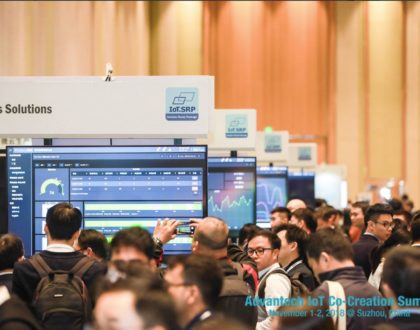Consumer Tech is Fun, But M2M Networking is Still the Top Banana
by Mike Fahrion
 Consumer Internet of Things technologies are generating a lot of excitement. Some are clearly going to be big hits. Others, like the Internet-enabled crockpots that I’ve seen for sale, may turn out to be as pointless as a Mikededicated banana slicer. (There are already 50 things in your kitchen that will slice a banana. But if you need yet another one, dedicated banana slicers are currently just $2.92 on Amazon, with free shipping for Amazon Prime members.) We’ll see how it all plays out.
Consumer Internet of Things technologies are generating a lot of excitement. Some are clearly going to be big hits. Others, like the Internet-enabled crockpots that I’ve seen for sale, may turn out to be as pointless as a Mikededicated banana slicer. (There are already 50 things in your kitchen that will slice a banana. But if you need yet another one, dedicated banana slicers are currently just $2.92 on Amazon, with free shipping for Amazon Prime members.) We’ll see how it all plays out.
In the meantime, industrial M2M networks are already using Internet of Things technologies to begin a steady, quiet, transformation of our entire world.
Take something as simple as irrigation, for example. Archeologists estimate that agriculture probably got started somewhere around about 10,000 B.C., with complex irrigation systems appearing by 8000 B.C. We’ve seen some improvements in the basic plumbing since then, and we’ve acquired electric motors to run the pumps and open the sluice gates. But it’s estimated that as much as 50 percent of irrigation water is still wasted due to evaporation or runoff. We’ve been building irrigation systems for 10,000 years, and after all this time we’re still doing it wrong.
That’s about to change. In Europe, the new WaterBee irrigation system monitors soil conditions in real time with a network of wireless sensors, and it uses the data to determine where and when water actually needs to be released. The test sites have reduced water usage by an average of 40 percent. That’s already impressive. It’s even more impressive if you stop to consider the fact that we’ve been working on this problem since the dawn of civilization.
And this is just the beginning.
Currently, the Waterbee system can decide whether a particular plot of land needs water, and it can provide the proper quantities as necessary. That’s a huge step forward. But turning this into more of an Internet of Things solution will make it even better. Systems like Waterbee will ultimately be able to access and interpret all kinds of additional data — like weather forecasts. If Mother Nature was about to provide water anyway, the irrigation system could wait, measure the new rainfall, and make a decision based upon the results.
Smart irrigation systems will be just one of countless transformative industrial Internet of Things technologies. By collecting new kinds of data, organizing that data in ways that can prompt useful responses, and expanding the network edge to include virtually any location on the planet, we will optimize efficiency, productivity, environmental sustainability and even safety.
A key piece of the puzzle will be the intelligent gateways that aggregate data from connected local sensors and devices, as well as external data feeds in the cloud, and make intelligent decisions based upon that information. In the case of an irrigation system, the gateway might apply a set of user defined rules like, “IF the soil is getting dry, AND evaporation levels are lower because it is after sundown, AND we have supply available, AND it is not about to rain, THEN turn on the pumps, release THIS amount of water and re-test.” The gateway would also observe additional parameters like pump current and water pressure. It would alert a service team if the pumps required preventive maintenance. It would detect and report leaks. At the same time, it would provide backhaul data connectivity to any and all of the appropriate applications. Depending upon the industry and the application, the gateway could report to anything from an accounting and billing department to a regulatory and compliance system.
Unlike opening a sluice gate to flood a field, the industrial Internet of Things will call for a lot of expertise. It will inevitably bring together multiple disciplines, multiple technologies, and multiple vendors. It will be hard to navigate this increasingly complex network environment without a lot of collaboration. Fortunately, B&B Electronics is long accustomed to working with partners, and we’re agnostic as to which applications platforms and services our customers prefer. We don’t compete with our partners and customers; we provide them with complete hardware stack to simplify and accelerate their development process and we even co-sell with them. When they close on their opportunities we all prosper.
One of the solutions that we and our partners are currently excited about is a new router being introduced by our European subsidiary, Conel. The new Conel Bivia v2 router has dual, independent communications modules. The dual modules not only allow the router to connect to two different cellular carriers at the same time, it can support two entirely different mobile technologies at the same time, such as UMTS/HSPA+, LTE, or CDMA. If one cellular connection should fail, the router will connect to the alternate cellular carrier in a matter of seconds, providing swift, automatic network backup in a single device. It uses the 4G LTE networks to provide Ethernet backhaul, excellent bandwidth and low latency for remote M2M devices and LANS, while simultaneously aggregating multiple data networking protocols from local devices; everything from Modbus to TCP/IP. There’s a lot of functionality packed into this compact, single box solution. In an emergency, you could probably even use it to disassemble a banana.
As always, if you have questions or comments about industrial M2M data networking, I’d love to hear from you.
Recommended Posts

Co-Creation, Paving the Way to a More Connected Future
November 27, 2018

The Benefits of a ‘Do It For Me’ Mentality in the IIoT
October 5, 2018

Why You Need to ‘Mind the Gap’ in Manufacturing Technology
August 31, 2018
